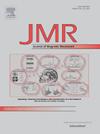Using PELDOR to count spins on multi-nitroxides
IF 1.9
3区 化学
Q3 BIOCHEMICAL RESEARCH METHODS
引用次数: 0
Abstract
We investigated the accuracy and limitation of using the modulation depth of pulsed electron-electron double resonance experiments to count the number of coupled spins. For this purpose, synthesized multi-nitroxide molecules with 2–6 spins were used. We could show that the main limitation on accurately counting larger number of coupled spins at Q-band frequencies is determined by the reproducibility of adjusting and calibrating the pump pulse excitation efficiency. Using broadband sech/tanh or short 10 ns rectangular pump pulses modulation depth suppression effects arising from non-ideal coverage of the dipolar-split signals can be avoided for molecules with intra-molecular spin distances larger than 2 nm. The transverse relaxation times for our model compounds with one to six spins did not depend on the spin number and were all the same. Nevertheless, the signal intensity of the primary Hahn echo signal in a 4-pulse PELDOR sequence decreased strongly with the number of coupled spins. This is due to the dipolar defocusing if more than one spin is excited by the first two pulses at the detection frequency, resulting in a loss of refocused echo intensity of the PELDOR experiments. This effect further reduces the accuracy of using the PELDOR modulation depth for spin counting. Altogether, our results demonstrate that this method is potentially applicable up to hexameric complexes with nitroxides.

用PELDOR来计算多氮氧化物的自旋
我们研究了利用脉冲电子-电子双共振实验的调制深度来计算耦合自旋数的准确性和局限性。为此,合成了具有2-6个自旋的多氮氧化物分子。我们可以证明,在q波段频率上精确计数较大数量的耦合自旋的主要限制是由泵浦脉冲激励效率的调整和校准的再现性决定的。对于分子内自旋距离大于2nm的分子,采用宽带(h/ h)或短(10ns)矩形泵浦脉冲调制深度可避免偶极分裂信号非理想覆盖引起的抑制效应。具有1 ~ 6个自旋的模型化合物的横向弛豫时间不依赖于自旋数,并且都是相同的。然而,在4脉冲PELDOR序列中,主Hahn回波信号的信号强度随着耦合自旋数的增加而明显降低。这是由于在探测频率下,如果前两个脉冲激发多个自旋,则会导致偶极散焦,从而导致PELDOR实验的重聚焦回波强度损失。这种效应进一步降低了使用PELDOR调制深度进行自旋计数的准确性。总之,我们的结果表明,这种方法是潜在的适用于六聚配合物与氮氧化物。
本文章由计算机程序翻译,如有差异,请以英文原文为准。
求助全文
约1分钟内获得全文
求助全文
来源期刊
CiteScore
3.80
自引率
13.60%
发文量
150
审稿时长
69 days
期刊介绍:
The Journal of Magnetic Resonance presents original technical and scientific papers in all aspects of magnetic resonance, including nuclear magnetic resonance spectroscopy (NMR) of solids and liquids, electron spin/paramagnetic resonance (EPR), in vivo magnetic resonance imaging (MRI) and spectroscopy (MRS), nuclear quadrupole resonance (NQR) and magnetic resonance phenomena at nearly zero fields or in combination with optics. The Journal''s main aims include deepening the physical principles underlying all these spectroscopies, publishing significant theoretical and experimental results leading to spectral and spatial progress in these areas, and opening new MR-based applications in chemistry, biology and medicine. The Journal also seeks descriptions of novel apparatuses, new experimental protocols, and new procedures of data analysis and interpretation - including computational and quantum-mechanical methods - capable of advancing MR spectroscopy and imaging.

 求助内容:
求助内容: 应助结果提醒方式:
应助结果提醒方式:


